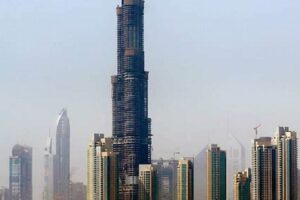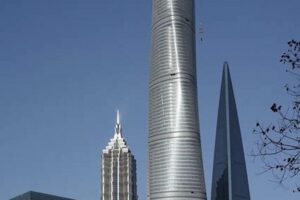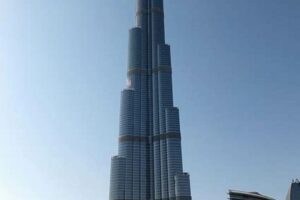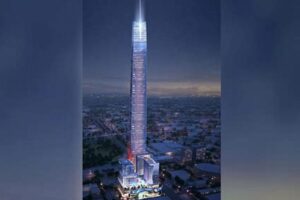A skyscraper is exceptionally tall, and the term often applies to buildings with over 40 floors. Reaching impressive heights and dominating skylines, skyscrapers serve various purposes such as residential, commercial, and mixed-use developments. Among these towering structures, one stands out as the tallest skyscraper in the world, a remarkable feat of engineering and architectural prowess.
The title of the world’s tallest skyscraper has been held by several iconic structures throughout history, each pushing the boundaries of architectural innovation. Currently, the Burj Khalifa in Dubai holds the title, standing at an awe-inspiring 828 meters (2,717 feet) with 163 floors. Completed in 2010, this magnificent skyscraper has become a global landmark and a symbol of Dubai’s rapid development and architectural ambition.
The construction of skyscrapers presents numerous challenges, including structural stability, wind resistance, and efficient elevator systems to navigate the immense height. Engineers and architects must meticulously design these buildings to withstand various environmental forces and ensure the safety and comfort of occupants.
Skyscrapers have revolutionized urban landscapes, allowing for increased population density in metropolitan areas. They offer breathtaking views from their upper floors and provide efficient use of valuable land space in densely populated cities. Additionally, skyscrapers serve as symbols of economic prosperity and technological advancement, attracting businesses and tourism to the cities they grace.
The pursuit of building the tallest skyscraper in the world continues to drive innovation and architectural exploration. It represents the human desire to push limits and create structures that touch the sky, shaping the skylines of cities around the globe and leaving a lasting legacy in the world of architecture and engineering.
1. Height
The towering height of the tallest skyscraper in the world is a defining characteristic that sets it apart and makes it a remarkable sight to behold. This exceptional height has several important implications:
- Landmark and Symbol: The sheer height of the tallest skyscraper makes it an iconic landmark, easily recognizable and often becoming a symbol of the city it resides in. Its towering presence on the skyline creates a distinct identity and draws attention from afar.
- Dominance and Prestige: Height has historically been associated with power and prestige, and the tallest skyscraper embodies this concept in the modern era. It represents the pinnacle of architectural achievement and becomes a source of pride for the city and its inhabitants.
- Engineering Marvel: Constructing a building of such immense height requires exceptional engineering prowess and innovation. The tallest skyscraper showcases the latest advancements in structural engineering, materials science, and construction techniques, pushing the boundaries of what is possible.
- Urban Planning and Density: In densely populated cities, building upwards allows for more efficient use of land space. The tallest skyscraper accommodates a significant number of people and functions within a relatively small footprint, contributing to sustainable urban planning and reducing sprawl.
In conclusion, the height of the tallest skyscraper in the world is not merely a physical attribute but a multifaceted aspect that encompasses architectural prowess, urban planning, and symbolic significance. It represents human ambition, engineering excellence, and the continuous drive to reach new heights, leaving a lasting impact on the urban landscape and the world of architecture.
2. Design
Innovative architectural design and engineering prowess are fundamental components that enable the construction and stability of the tallest skyscraper in the world. This is because immense height poses significant structural challenges that require creative and advanced solutions.
One crucial aspect is the building’s core, which acts as its backbone. Engineers design these cores to be exceptionally strong and rigid, using reinforced concrete or steel structures to withstand the immense weight and lateral forces acting on the skyscraper. These cores provide stability against wind loads, seismic activity, and other external forces.
Another critical element is the building’s facade, which plays a vital role in maintaining structural integrity. The facade must be lightweight yet strong enough to resist wind pressure and potential debris impact. Advanced materials, such as high-performance glass and composite panels, are often used to achieve this balance.
Furthermore, architects and engineers employ innovative design strategies to optimize the building’s shape and form. They may incorporate aerodynamic features to reduce wind resistance and utilize advanced damping systems to mitigate vibrations caused by strong winds and earthquakes.
In conclusion, the design of the tallest skyscraper in the world is a testament to human ingenuity and the continuous pursuit of architectural and engineering excellence. It showcases the ability to overcome structural challenges and create buildings that push the boundaries of what is possible, redefining the skylines of cities worldwide.
3. Construction
The construction of the tallest skyscraper in the world is a complex and demanding process that requires meticulous planning, advanced techniques, and specialized materials to ensure the safety and durability of the structure. Each aspect plays a crucial role in ensuring that the building can withstand various challenges and provide a safe and habitable environment for its occupants.
Meticulous planning involves careful consideration of every detail, from the foundation to the rooftop. Engineers and architects must account for factors such as soil conditions, wind loads, seismic activity, and potential natural disasters. Advanced techniques, such as computer modeling and simulations, help optimize the building’s design and predict its behavior under different conditions.
Specialized materials are essential for constructing a skyscraper that can reach extreme heights. High-strength concrete, reinforced steel, and lightweight composite materials are often used to create a robust and resilient structure. These materials allow the building to withstand the immense weight and lateral forces acting upon it.
The construction process itself is a marvel of engineering. Specialized equipment and skilled workers are required to assemble the building’s components safely and efficiently. Continuous monitoring and quality control measures ensure that the highest standards are met throughout the construction phase.
The importance of meticulous planning, advanced techniques, and specialized materials cannot be overstated. These elements are fundamental to the successful construction of the tallest skyscraper in the world, ensuring that it remains a safe and habitable structure for decades to come.
4. Purpose
The tallest skyscraper in the world is not merely a towering structure but also a multifaceted complex that serves a wide range of purposes, fulfilling diverse needs and functions within the urban environment.
- Residential: Many of the tallest skyscrapers in the world incorporate residential units, offering luxurious living spaces with breathtaking views and exclusive amenities. These residences provide a unique and prestigious lifestyle, attracting affluent individuals and families.
- Commercial: The vast floor space within these skyscrapers accommodates a multitude of commercial activities, including offices, retail stores, conference centers, and more. By centralizing businesses in a single location, skyscrapers promote efficiency, collaboration, and accessibility.
- Mixed-use: The tallest skyscrapers often adopt a mixed-use approach, combining residential, commercial, and even hospitality components under one roof. This integrated design creates vibrant and self-contained communities, where people can live, work, and socialize without the need for extensive commuting.
- Public and Cultural: Some of the world’s tallest skyscrapers incorporate public spaces, observation decks, and cultural venues, making them accessible to the general public. These spaces offer panoramic views, host events, and contribute to the cultural fabric of the city.
In conclusion, the diverse purposes and functions served by the tallest skyscraper in the world highlight its significance as more than just a building. It serves as a hub for living, working, leisure, and cultural activities, contributing to the economic vitality, social interaction, and overall quality of life within the urban environment.
5. Symbolism
The tallest skyscraper in the world often embodies the economic prosperity and technological advancement of the city and region it resides in. It serves as a physical manifestation of a city’s ambition, financial strength, and commitment to innovation.
- Economic Prosperity: Skyscrapers are often constructed during periods of economic growth and stability. They represent the ability of a city to invest in large-scale projects and attract businesses and investors. The presence of a towering skyscraper can boost the city’s image as a thriving and prosperous hub.
- Technological Advancement: The construction of a skyscraper requires cutting-edge engineering and architectural techniques. It showcases the latest advancements in materials science, structural design, and construction methods. Skyscrapers push the boundaries of human ingenuity and serve as testaments to the capabilities of modern engineering.
- Urban Identity: Skyscrapers become iconic landmarks and symbols of the cities they inhabit. They shape the skyline and create a distinct identity for the urban landscape. The tallest skyscraper in the world often represents the city’s aspirations and its place in the globalized world.
- National Pride: In some cases, the tallest skyscraper in the world can become a source of national pride and a symbol of a country’s economic and technological prowess. It can inspire awe and admiration, showcasing the nation’s capabilities and ambition on a global stage.
In conclusion, the symbolism associated with the tallest skyscraper in the world extends beyond its physical presence. It represents economic prosperity, technological advancement, urban identity, and national pride, reflecting the ambitions and achievements of the city and region it calls home.
6. Challenge
The pursuit of constructing the tallest skyscraper in the world presents a significant challenge that has consistently driven architectural innovation and progress. It requires architects and engineers to overcome numerous technical and structural obstacles, leading to advancements in design, materials, and construction techniques.
One of the most significant challenges lies in ensuring the structural stability of these towering structures. As skyscrapers reach unprecedented heights, they must withstand strong winds, seismic forces, and other environmental loads. This has led to the development of innovative structural systems, such as diagrid frameworks and outrigger systems, which enhance the building’s resistance to lateral forces and improve overall stability.
Another challenge involves developing efficient and sustainable building systems. Tall buildings consume a substantial amount of energy, so architects and engineers must find ways to reduce their environmental impact. This has led to the integration of green technologies, such as energy-efficient lighting systems, rainwater harvesting systems, and renewable energy sources, into the design of skyscrapers.
The pursuit of constructing the tallest skyscraper in the world has also driven advancements in materials science. The use of high-strength concrete, composite materials, and lightweight alloys has enabled the construction of buildings that are both strong and lightweight. These advanced materials allow architects to create structures that can withstand extreme loads while minimizing the overall weight of the building.
In conclusion, the challenge of building the tallest skyscraper in the world has been a catalyst for architectural innovation and progress. It has led to the development of new structural systems, sustainable building technologies, and advanced materials, pushing the boundaries of architectural possibility and shaping the skylines of cities around the globe.
7. Landmark
As the tallest skyscraper in the world, it commands attention and becomes an iconic symbol of the city it resides in. Its towering height and distinctive design make it a recognizable landmark, attracting tourists and global recognition. This landmark status brings numerous benefits to the city:
- Tourism: The tallest skyscraper in the world attracts tourists from around the globe, eager to witness its grandeur and experience the breathtaking views from its observation decks. This influx of tourism stimulates the local economy, creating jobs and supporting businesses.
- Global Recognition: The presence of the tallest skyscraper in the world elevates the city’s profile on the international stage. It becomes a symbol of progress, innovation, and economic prosperity, attracting businesses and investors.
- Cultural Significance: Over time, the tallest skyscraper in the world becomes an integral part of the city’s cultural identity. It serves as a backdrop for major events, inspires local artists and architects, and becomes a source of pride for the city’s residents.
In conclusion, the landmark status of the tallest skyscraper in the world is a valuable asset to the city it resides in. It attracts tourism, enhances global recognition, and contributes to the city’s cultural significance, making it a desirable destination for both visitors and businesses alike.
FAQs about the Tallest Skyscraper in the World
The pursuit of constructing the tallest skyscraper in the world has captivated the imaginations of architects, engineers, and the general public alike. Here are answers to some frequently asked questions about these architectural marvels:
Question 1: What is the current tallest skyscraper in the world?
Answer: As of 2023, the Burj Khalifa in Dubai, United Arab Emirates, holds the title of the tallest skyscraper in the world, standing at an impressive height of 828 meters (2,717 feet) with 163 floors.
Question 2: What are the key challenges in constructing such tall buildings?
Answer: Constructing skyscrapers presents numerous challenges, including structural stability against strong winds and seismic activity, efficient elevator systems to navigate the immense height, and sustainable design to minimize environmental impact.
Question 3: How do skyscrapers withstand strong winds and earthquakes?
Answer: Skyscrapers employ innovative structural systems, such as diagrid frameworks and outrigger systems, which enhance their resistance to lateral forces. Advanced materials like high-strength concrete and composite materials contribute to the overall stability of these structures.
Question 4: What are the benefits of building tall skyscrapers?
Answer: Skyscrapers offer several benefits, including efficient use of land space in densely populated urban areas, breathtaking views from upper floors, and the potential to serve as iconic landmarks and symbols of economic prosperity.
Question 5: How do skyscrapers contribute to sustainable development?
Answer: Modern skyscrapers incorporate sustainable design features, such as energy-efficient lighting systems, rainwater harvesting systems, and renewable energy sources, to reduce their environmental impact and promote sustainable urban development.
Question 6: What is the future of skyscraper construction?
Answer: The future of skyscraper construction is expected to focus on sustainability, innovation, and technological advancements. Architects and engineers are continuously exploring new designs, materials, and construction techniques to push the boundaries of architectural possibility and create even taller and more sustainable skyscrapers.
In conclusion, the pursuit of building the tallest skyscraper in the world showcases human ingenuity, engineering prowess, and the drive for architectural innovation. These towering structures serve as symbols of economic strength, technological advancement, and sustainable urban development, shaping the skylines of cities around the globe.
Transition to the next article section: “The Impact of Skyscrapers on Urban Development”
Tips Related to the Tallest Skyscraper in the World
The construction and maintenance of the tallest skyscraper in the world require meticulous planning, advanced engineering, and sustainable practices. Here are some key tips to consider:
Tip 1: Prioritize Structural Stability and Safety: Ensure the building’s foundation, core, and facade are designed to withstand strong winds, seismic forces, and other potential hazards.
Tip 2: Implement Sustainable Design Features: Incorporate energy-efficient systems, rainwater harvesting, and renewable energy sources to minimize environmental impact and promote sustainability.
Tip 3: Utilize Advanced Materials and Technologies: Employ high-strength concrete, composite materials, and innovative construction techniques to enhance structural integrity and durability.
Tip 4: Plan for Efficient Vertical Transportation: Design efficient elevator systems and consider alternative modes of transportation, such as skybridges or vertical railways, to manage high occupant volumes.
Tip 5: Create Multi-Functional Spaces: Maximize space utilization by incorporating mixed-use designs that combine residential, commercial, and public functions within the skyscraper.
Tip 6: Invest in Regular Maintenance and Inspections: Establish a comprehensive maintenance plan to ensure the ongoing safety and performance of the skyscraper throughout its lifespan.
Tip 7: Foster Collaboration and Innovation: Encourage collaboration among architects, engineers, and construction professionals to push the boundaries of design and engineering.
Tip 8: Consider Long-Term Sustainability: Design the skyscraper with adaptability and future upgrades in mind to ensure its relevance and sustainability over time.
By following these tips, stakeholders can contribute to the successful construction and operation of the tallest skyscraper in the world, ensuring its structural integrity, environmental sustainability, and enduring legacy.
Transition to the article’s conclusion:
The pursuit of constructing and maintaining the tallest skyscraper in the world is an ongoing endeavor that requires meticulous planning, cutting-edge technology, and a commitment to sustainability. By embracing these tips, we can create architectural marvels that not only reach for the sky but also contribute to the well-being of our communities and the preservation of our planet.
Conclusion
The pursuit of constructing the tallest skyscraper in the whole world is a testament to human ambition, engineering prowess, and architectural innovation. These towering structures push the boundaries of possibility, redefine skylines, and serve as symbols of economic prosperity and technological advancement. However, beyond their height and grandeur, the tallest skyscrapers also present unique challenges and opportunities.
To successfully design, construct, and maintain these architectural marvels, meticulous planning, advanced engineering techniques, and a commitment to sustainability are paramount. By embracing innovative materials, efficient systems, and collaborative approaches, we can create skyscrapers that are not only structurally sound but also environmentally responsible and adaptable to future needs. In doing so, we can ensure that the tallest skyscrapers in the world continue to inspire awe and serve as beacons of human ingenuity for generations to come.







